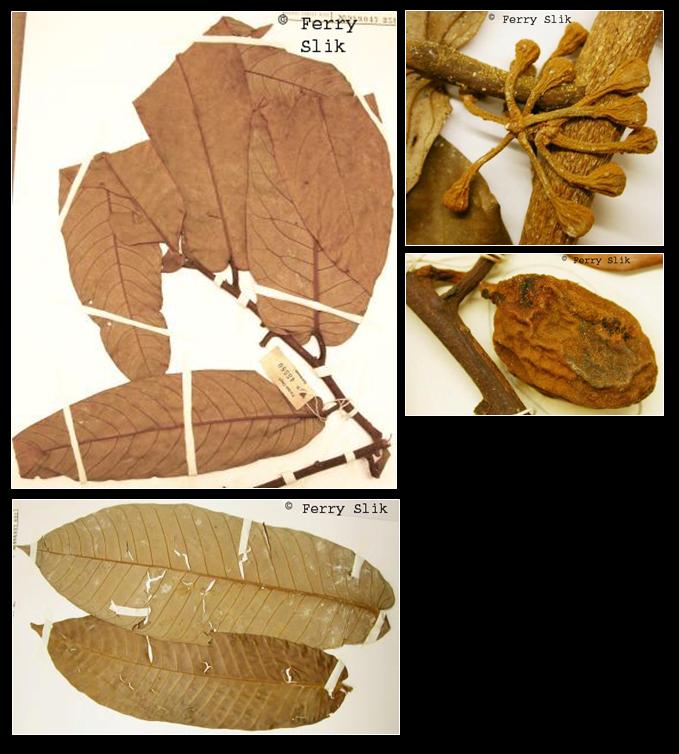Knema pulchra (Miq.) Warb., Mon. Myrist. (1897)
Latin for 'beautiful'.Synonyms
Knema cinerea var. cordata (J.Sinclair) J.Sinclair
Knema glaucescens var. cordata J.Sinclair
Myristica pulchra Miq.
Diagnostics
Sub-canopy tree up to 22 m tall and 31 cm dbh. Sometimes with a few stilt-roots; bark smooth
with a few lenticels, pustulate, or finely fissured; living bark orange-brown; wood pale brown
or white. Leaves dark green with whitish green midrib and nerves above, glaucous with brownish
midrib and nerves beneath. Perianth pale brown or cream inside.
Fruits ca. 35 mm long, yellow-orange-red, glabrous to hairy, dehiscent capsules.
Seeds with nearly undivided red aril.
Description
Tree (2.5-)6-15(-22) m. Twigs 3-6(-8) mm diameter, at first with short grey brown to
rusty hairs 0.1 mm long, glabrescent; bark finely striate, not tending to crack or flake.
Leaves chartaceous or thinly coriaceous, elliptic-oblong to oblong-lanceolate, (20-)30-
50 by (6-)10-17 cm, base rounded or cordate, apex acute(-acuminate); drying greenish
brown, often +/- glossy above; lower surface with persistent or deciduous sparse pale
brown or greyish stellate hairs 0.1-0.2 mm long; dots absent; midrib raised above; nerves
18-25 pairs, +/- flat above; venation (in)distinct; petiole 15-40 by 3-5 mm. Inflorescences:
sessile, brachyblast simple, warted, or 2- or 3-furcate, to 10 mm long, in male
1-10-flowered, female 1-5-flowered; flowers with greyish brown hairs 0.1 mm long or
less; perianth 3-lobed. creamy or pale brown inside. Male flowers: pedicel 4-8 mm
long, bracteole caducous or subpersistent. median to subapical; buds obovoid, (3-)4-5.5
by 3-5 mm, cleft 1/2-3/4, lobes 0.7-1 mm thick; staminal disc circular or faintly triangular,
flat or concave, 1.8-3 mm diameter; anthers 12-25 (14-25 in Borneo), +/- halferect,
just sessile, 0.5-0.7 mm long, not or only little touching; androphore slender,
sometimes tapering, 0.8-1.5 mm long. Female flowers: pedicel (2-)5-8 mm long, bracteole
about median; buds obovoid-oblong, 5-6 by 3.5-4.5 mm, cleft c. 1/2, lobes 1 mm
thick; ovary ovoid, 2.5-3 by 1.5-2 mm; style 1.5 mm long, stigma ¡À flat, inconspicuously
2-lobed and each lobe again 2-4(-5)-lobulate. Fruits variable, 1 or 2 per infructescence,
subglobose to ellipsoid-oblong, ridged and sometimes slightly saccate at base
or not, apex obtuse to subacute, (3-)4-6 by 2-3.5 cm, with hairs (0.1-)0.2 mm long,
sometimes glabrescent; dry pericarp 3-4 mm thick; fruiting pedicel (2-)5-12 mm long.
[from Flora Malesiana]
Ecology
In undisturbed mixed dipterocarp to sub-montane forests up to 1200 m
altitude. On hillsides and ridges, but also along streams and rivers and in swamps. On sandy
to clay soils, also on limestone.
Distribution
Peninsular Malaysia, Borneo.
Local names
Borneo: Darah-darah, Kumpang, Mandarahan.
